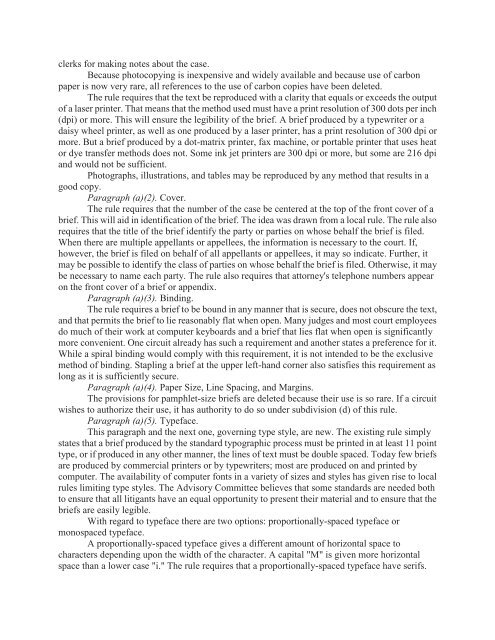Federal Rules of Appellate Procedure 2014-2015, 2014a
Federal Rules of Appellate Procedure 2014-2015, 2014a
Federal Rules of Appellate Procedure 2014-2015, 2014a
You also want an ePaper? Increase the reach of your titles
YUMPU automatically turns print PDFs into web optimized ePapers that Google loves.
clerks for making notes about the case.<br />
Because photocopying is inexpensive and widely available and because use <strong>of</strong> carbon<br />
paper is now very rare, all references to the use <strong>of</strong> carbon copies have been deleted.<br />
The rule requires that the text be reproduced with a clarity that equals or exceeds the output<br />
<strong>of</strong> a laser printer. That means that the method used must have a print resolution <strong>of</strong> 300 dots per inch<br />
(dpi) or more. This will ensure the legibility <strong>of</strong> the brief. A brief produced by a typewriter or a<br />
daisy wheel printer, as well as one produced by a laser printer, has a print resolution <strong>of</strong> 300 dpi or<br />
more. But a brief produced by a dot-matrix printer, fax machine, or portable printer that uses heat<br />
or dye transfer methods does not. Some ink jet printers are 300 dpi or more, but some are 216 dpi<br />
and would not be sufficient.<br />
Photographs, illustrations, and tables may be reproduced by any method that results in a<br />
good copy.<br />
Paragraph (a)(2). Cover.<br />
The rule requires that the number <strong>of</strong> the case be centered at the top <strong>of</strong> the front cover <strong>of</strong> a<br />
brief. This will aid in identification <strong>of</strong> the brief. The idea was drawn from a local rule. The rule also<br />
requires that the title <strong>of</strong> the brief identify the party or parties on whose behalf the brief is filed.<br />
When there are multiple appellants or appellees, the information is necessary to the court. If,<br />
however, the brief is filed on behalf <strong>of</strong> all appellants or appellees, it may so indicate. Further, it<br />
may be possible to identify the class <strong>of</strong> parties on whose behalf the brief is filed. Otherwise, it may<br />
be necessary to name each party. The rule also requires that attorney's telephone numbers appear<br />
on the front cover <strong>of</strong> a brief or appendix.<br />
Paragraph (a)(3). Binding.<br />
The rule requires a brief to be bound in any manner that is secure, does not obscure the text,<br />
and that permits the brief to lie reasonably flat when open. Many judges and most court employees<br />
do much <strong>of</strong> their work at computer keyboards and a brief that lies flat when open is significantly<br />
more convenient. One circuit already has such a requirement and another states a preference for it.<br />
While a spiral binding would comply with this requirement, it is not intended to be the exclusive<br />
method <strong>of</strong> binding. Stapling a brief at the upper left-hand corner also satisfies this requirement as<br />
long as it is sufficiently secure.<br />
Paragraph (a)(4). Paper Size, Line Spacing, and Margins.<br />
The provisions for pamphlet-size briefs are deleted because their use is so rare. If a circuit<br />
wishes to authorize their use, it has authority to do so under subdivision (d) <strong>of</strong> this rule.<br />
Paragraph (a)(5). Typeface.<br />
This paragraph and the next one, governing type style, are new. The existing rule simply<br />
states that a brief produced by the standard typographic process must be printed in at least 11 point<br />
type, or if produced in any other manner, the lines <strong>of</strong> text must be double spaced. Today few briefs<br />
are produced by commercial printers or by typewriters; most are produced on and printed by<br />
computer. The availability <strong>of</strong> computer fonts in a variety <strong>of</strong> sizes and styles has given rise to local<br />
rules limiting type styles. The Advisory Committee believes that some standards are needed both<br />
to ensure that all litigants have an equal opportunity to present their material and to ensure that the<br />
briefs are easily legible.<br />
With regard to typeface there are two options: proportionally-spaced typeface or<br />
monospaced typeface.<br />
A proportionally-spaced typeface gives a different amount <strong>of</strong> horizontal space to<br />
characters depending upon the width <strong>of</strong> the character. A capital "M" is given more horizontal<br />
space than a lower case "i." The rule requires that a proportionally-spaced typeface have serifs.


















